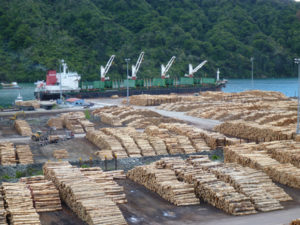Lack of space in Chinese ports is bringing a virtual halt to New Zealand log exports to China. The Forest Owners Association says precautions in China against coronavirus have resulted in almost no offtake of logs in China for processing and exporters understand that the remaining log yard space at most ports near processing centres is quickly disappearing. Source: Timberbiz
Association President, Peter Weir says exporters had hoped that business would return to normal after the extended Lunar New Year holiday finished in China two weeks ago.
“That hasn’t happened. Many Chinese sawmills are yet to get back to work,” Mr Weir said.
“New Zealand exporters have nowhere else to send the industrial grade logs they harvest.”
While New Zealand’s domestic sawmills usually took about 40 percent of the harvest, sawmills supplying the New Zealand housing market would only buy stiffer and higher quality sawlogs or knot-free logs from pruned trees for joinery. The upper logs from a pruned true often graded out as industrial logs, and these logs were exported.
“In regions where there is no domestic sawmilling, many harvest contracting crews are being put on reduced hours or, worst case, stood down. Regrettably many of our contractors have little alternative but to lay-off skilled workers,” Mr Weir said.
Log exports to China were worth $2.7 billion for the year to the end of December 2019.
Over the past three months very large volumes of European spruce salvaged from forests under attack by insects have been shipped into log markets in China.
Mr Weir said that that flood of salvaged logs is directly attributable to climate change with recent warm winters and longer summers.
“There would have been much less inventory pressure if these exports had not arrived in China, but the concern about coronavirus has happened at just the wrong time for New Zealand,” he said.
Mr Weir said the situation was fluid with different forest owners and management companies taking different approaches.
“NZFOA members are doing what we can to retain our skilled labour force by sending better logs to domestic sawmills to make up for the shortfall from farm woodlots where logging has already ceased,” he said.
“We continue to invest in the silvicultural work, including pruning, thinning and preparing recently harvested land before replanting begins in May or June.”
He said most members would continue building safe forest roads and landings to be harvest-ready when markets recover. But that could take some months.
Many larger forest companies were assisting contractors with business management and financial advice.
“In Poverty Bay, we are delighted with the support we are receiving from local Federated Farmers who are looking for jobs to employ forest workers,’’ Mr Weir said.
“Every few extra hours of income are most welcome.”
Mr Weir said the Forest Owners Association was working closely with Te Uru Rākau in trying to lessen the impact of the log supply situation.
“We are coordination with the government seeing what we can do together. Neither of us can solve this situation but working together as a partnership will lessen the impact,” he said.
“Our members are not looking for handouts, but we do want to work out equitable ways for working with the government to assist the various harvesting crews. They are ones who will need the help.
“We are mindful too that a substantial reduction in harvesting is likely to have a major and rapid supply chain effect here in New Zealand, with a large dedicated workforce in trucking and port loading which is also going to feel the impact.”






